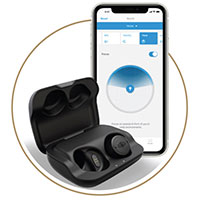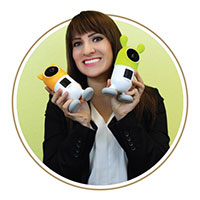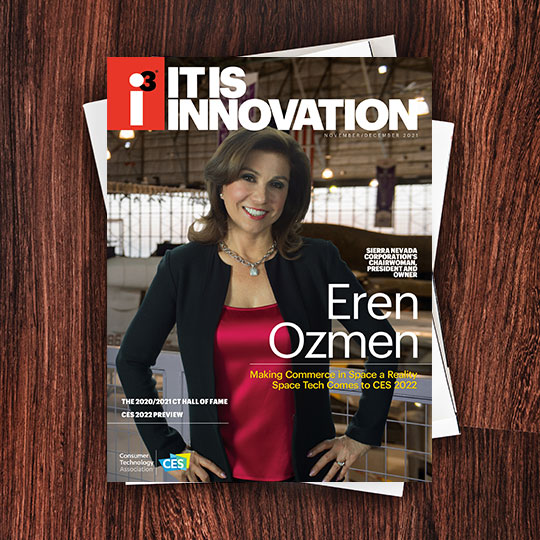2021 Executive of the Year
Dr. James Mault
“Medical Grade Remote Care is Here,” proclaims the home page of BioIntelliSense, founded by Dr. James Mault. He has perhaps done more than any individual to pioneer technology-based solutions for remote patient monitoring and to drive virtual medical care to routine clinical practice. Through its medical-grade Data-as-a-Service platform and wearable devices, Dr. Mault and BioIntelliSense have helped usher in the era of virtual health.
James Mault, born in 1961, grew up in Olmsted Falls, Ohio, where his parents were teachers. His dream of becoming a surgeon began after attending a medical seminar in seventh grade. When his father died during his first week of college, Dr. Mault sought employment at the University of Michigan Hospital to self-finance his education. He was hired as a medical technician by Dr. Robert Bartlett, a highly regarded surgeon-entrepreneur. Surrounded by technology in the ICU, Dr. Mault built his first medical device and authored his first medical journal article at 19. At the same time, he earned his bachelors and cum laude medical degrees from the University of Michigan in 1984 and 1988, respectively, and completed his general and cardiothoracic surgery residency at Duke University Medical Center in 1997. He then joined the faculty of the University of Colorado Health where he practiced thoracic surgery, heart and lung transplantation, and served as Chief of Thoracic Surgery at the Denver VAH.
After developing monitoring technologies for the ICU, Dr. Mault began to focus on the care and monitoring of patients at home after leaving the hospital. He embarked on an entrepreneurial career, founding and leading a series of startups, as well as the medical divisions of both Microsoft and Qualcomm. The companies developed various remote health technologies including the first web-based applications for healthcare professionals to monitor patients using mobile devices, post-hospital discharge home health monitoring products, a consumer-controlled health record system, a cloud-based SaaS platform for care coordination and family caregiving. Two of these companies were developed with his wife, Denisa Ronzani, also a successful entrepreneur.
Dr. Mault founded BioIntelliSense in 2018 as the “grand finale” in his pursuit of a ubiquitous application of remote patient monitoring across medicine. By January 2020, Dr. Mault as CEO, his co-founder Dave Wang and the BioIntelliSense team announced the FDA clearance of the BioSticker, an on-body sensor that allows for effortless continuous monitoring of vital signs and actionable insights, delivered to clinicians from patients at home, allowing early detection of potential complications. In late 2020, BioIntelliSense launched the BioButton, a coin-sized, low-cost disposable medical grade device that continuously measures vital signs for up to 60 days. He also serves on CTA’s Executive Board.
“Since the turn of the century, digital health has held great promise to transform the delivery of health care,” Dr. Mault says. “We are finally at that tipping point in using technology to enable better healthcare to more people at a fraction of the cost.” Because of his work in virtual care and remote patient monitoring, patients can now be safely cared for at home.
 2021 Company of the Year
2021 Company of the Year
Nuheara
Since the introduction of its first IQbuds with augmented hearing capabilities in 2016, Nuheara has been a pioneer in the “hearables” category, with its recent IQbuds2 Max helping to make hearables the fastest growing wearable segment. Nuheara’s delivery of hearing assistance to millions of people via true wireless buds is truly disruptive.
Nuheara’s Australian-born co-founders, David Cannington and Justin Miller began working together in 2005 at Sensear, a Perth-based company founded by Miller that designs and manufactures smart industrial hearing protection devices. Their products were life-changing for men suffering age- and job-related hearing loss and they wondered if they could make a smaller version for consumer use.
In 2014, they began to formulate a business plan for Nuheara – short for “a new way to hear.” They had three goals: the solution had to wirelessly connect to smart devices and stream audio, it had to have plenty of battery power, and it had to enable augmented hearing with a focus on separating speech from other ambient noise to boost conversations. They needed a digital signal processing expert, and convinced former Sensear CTO Dr. Alan Davis to develop a new solution for the consumer market.
Within a year, Nuheara raised $5 million from seed investors, a “reverse” listing on the Aussie stock exchange and $1 million from a 2016 Indiegogo campaign. The company went from a wearable prototype in January 2016 to a production ready product that premiered at CES 2017.
Consumers loved the IQbuds but wanted more personalization so that the buds operated more like a hearing aid. Nuheara partnered with National Acoustics Laboratories in Sydney, a leading hearing research institution renowned for creating NAL-NL2, algorithms used by audiologists worldwide to calibrate high-end hearing aids. These calibration algorithms were embedded in the new buds, along with a new clinically validated hearing assessment to create Ear ID, the first true personalization in a consumer hearable device. IQbuds Boost with Ear ID launched at CES 2018 and went on sale in May 2018.
In 2019, the Nuheara team began redesigning its buds, developing its own Speech in Noise Control (SINC) technology to enhance normal hearing and allow wearers to enjoy high fidelity music, conversations or silence. The resulting IQbuds2 Max with active noise cancellation debuted at CES 2020. IQbuds2 Max have won numerous global innovation awards, including a Time Magazine 2020 Best Invention. Along with its new IQstream TV for private IQbuds TV listening, Nuheara generated $10.5 million in revenue in its last fiscal year, a 517% YOY leap.
The company is working on the next generation of IQbuds to create a revolutionary hearing aid in a true wireless bud, continuing Nuheara’s hearable trailblazing.
 2021 Startup of the Year
2021 Startup of the Year
ROYBI
Being multilingual is a valuable professional skill in a globalized world. Most experts agree the prime second-language learning time is childhood. Understanding the importance of children learning non-native languages, Elnaz Sarraf created ROYBI, the world’s first and only AI-powered educational companion that tutors young children in languages.
Sarraf experienced the value of learning a second language as a child. Born in Tehran, Iran, her father bought her a PC when she was five to learn English, when there were fewer than 10 in the entire country. She moved to the U.S. in 2007 to attend California State University. “Knowing English and American culture helped me adjust to the new country and excel in my studies,” Sarraf says. “I experienced firsthand how learning a different language early on in life can help reach your goals later in life.”
In 2013, Sarraf successfully co-launched iBaby, Wi-Fi smart video baby monitors sold in over 5,000 stores worldwide. “I wanted to make a bigger impact and education has always been close to my heart.” She decided to focus on technology and AI to help children learn languages, an idea she shared with former iBaby CTO and parent Ron Cheng.
Over 18 months, they designed an interactive educational toy robot they dubbed ROYBI. The built in Automatic Speech Recognition Engine (ASR), developed for kids with privacy in mind, more than 3500 hours of machine training, and Edge AI (on-device recognition) allows ROYBI to interact with children even without internet connectivity. ROYBI continuously analyzes children’s speech and vocabulary acquisition, learning each child’s unique communicative behaviors and skills. “We also wanted the experience of learning and interacting with ROYBI Robot to interest children in STEM topics,” Sarraf explains.
Sarraf and Cheng wanted a friendly gender-neutral robot to build trust, and the bundled collection of colored hats and accessories allow children to create a ROYBI unique to them. Only six-inches tall, a child can hold ROYBI in their hands and interact with it close-up.
After running out of cash twice, they reached out to investors, collecting more than 200 rejections. They convinced a factory to build a few prototypes and once they had samples to demonstrate their concept, they secured an initial $4.2 million in funding.
ROYBI launched as an Indiegogo campaign in November 2019. Sarraf and Cheng were surprised when ROYBI, featuring more than 500 lessons in 70 categories and over 70,000 words in English and Chinese, was named a Time Magazine Best Invention. ROYBI launched in May 2020 and is sold in more than 130 retail outlets.
 Inaugural John and Jane Shalam Award
Inaugural John and Jane Shalam AwardTo recognize the work being done to connect isolated seniors, the CTA Foundation has created the John and Jane Shalam Award to Combat Social Isolation. The winner this year is Selfhelp Community Services, the CTA Foundation’s first grant recipient in 2012. Selfhelp is dedicated to using technology to help improve the quality of life for older adults. Their “Virtual Senior Center” helps develop strong relationships among the participants and has gained the reputation of relieving the social isolation of disadvantaged older adults. With over 2000 participants and 28,000 live online classes, Selfhelp is truly making a difference.
 2020 Executive of the Year
2020 Executive of the YearWhen her four-year-old daughter was suffering from night terrors in 2015, Vicki Mayo called her friend, Dr. Amy Serin, a neuropsychologist. Dr. Serin was working on a technology to help people reduce stress and anxiety levels. Mayo’s daughter tried Serin’s solution the next night and fell asleep within 30 seconds, waking the next day refreshed.
Mayo believed that Serin’s technology was too powerful to simply be a research study. In December 2016, the first TouchPoint Solution stress-reducing wrist wearable was launched. Mayo has since led TouchPoint Solution to more than $2 million in annual sales and more than 75 accolades for the technology.
Raised in an entrepreneurial home, her father came from India with $2 and now owns hotels across the U.S., assisted by Mayo’s mother. She learned many lessons from her parents including, “The difference between ordinary and extraordinary is just a little ‘extra’.”
At 14, she built a computer system and established a travel agency, which she later sold for a profit. After graduating from Northern Arizona University in 2005, Mayo made a decision that changed her life. She adopted two boys she had found living alone in an apartment, abandoned by their parents. Two years later, she married Simer Mayo, then founded Mayo Hospitality Management, a management company focused on servicing boutique hotels. In 2011, she sold the company and focused on their other companies — Valor Global and GMI.
After solving her daughter’s night terrors, Mayo worked to create a consumer product. She built out algorithms and developed a wireless wearable design that used patent-pending technology, BLAST (bi-lateral alternating stimulation-tactile technology). The TouchPoints wearables emit vibrations that alter the body’s stress-induced “fight or flight” response. Research showed that within 30 seconds, people experienced a 74% reduction in stress levels and a 68% reduction in stress-related body sensations. Triple blind placebo-controlled studies show that TouchPoints not only stabilize cortisol levels during stressful events, but reduce cortisol levels 20 minutes later when cortisol traditionally spikes.
The business remains totally self-funded and owned by Mayo. Within the first 30 days of availability in December 2016, the company piled up more than $250,000 in sales. The product line now includes several TouchPoints wearables, including one for Calm and one for Sleep.
Mayo says, “From overcoming childhood adversity to learning to manage their anger and becoming more productive at work — TouchPoints have helped more than three million people across the world live better lives through neuroscience, including myself and my family.”
 2020 Company of the Year
2020 Company of the Year
re:3D
Throughout their travels volunteering for NASA’s Engineers Without Borders (EWB), Samantha Snabes and Matthew Fiedler encountered sad scenes of abandoned gear and unused medical equipment, along with enormous piles of plastic waste. Over a beer in Rwanda, Snabes and Fiedler developed a novel idea: an affordable, large-scale 3D printer to enable someone to print solutions that used locally reclaimed plastic waste.
The result was the re:3D Gigabot, the world’s largest, industrial FFF (fused filament fabrication) 3D printer, priced under $9000. Snabes and Fiedler fulfilled their vision with the revolutionary Gigabot X FGF (fused granular fabrication), which prints from recycled local plastic waste – a breakthrough in affordable and ecologically responsible industrial printing.
Born in Detroit, Snabes dreamed of becoming an astronaut, earning diverse degrees and an MBA in supply chain management. She helped build an artificial immune system under a DARPA grant, which led her to NASA. Fiedler was one of 10 children raised on an Iowa farm. Trained as a machinist, he earned degrees in biomechanics and biomedical engineering, and became fascinated by 3D printing. They met while both were working in the Space Life Sciences Directorate and volunteering for EWB.
Snabes and Fiedler first presented their idea for a “toilet-sized 3D printer” as a finalist in a tech innovation competition. Next, the pair applied to Start-Up Chile, and were awarded $40,000. Their company name reflected their dual objectives: 3D and “re,” short for recycling, re-doing and re-envisioning. After unveiling a prototype at South By Southwest, they launched a Kickstarter campaign and met their funding goal in just 27 hours, raising $250,000 in 60 days.
Several NASA compatriots pitched in, and re:3D shipped the first Gigabot in September 2013. The original Gigabot printed from hard-to-find and expensive filament. But Snabes realized that printing directly from ground up or pelletized plastic could be more affordable and accessible. The Gigabot X FGF, went on sale in 2019, and can print directly from cheaper and widely available recycled pellets or from easily ground or shredded local plastic waste.
Re:3D expects a 15-20% YOY revenue rise in 2020. Re:3D has generated more than $8 million in sales in 50-plus countries. And re:3D donates one 3D printer to someone trying to make a difference in their community for every 100 units delivered.
Snabes says, “In addition to providing a platform to explore sustainable closed-loops applications globally, multiple enterprises are using Gigabot X to create new materials on demand or to benefit from printing faster and at a lower cost with pellets and flake.”
 2020 Startup of the Year
2020 Startup of the Year
Nuro
A small vehicle resembling a white toaster on wheels rolls up to your home, you tap a code received by text on the vehicle’s touchscreen. A contoured wing door rises to reveal the groceries you ordered. Removing your items, you tap “DONE” and the vehicle rolls off to its next stop. Oh, one thing. There’s no one driving this futuristic vehicle.
The brainchild of Dave Ferguson and Jiajun Zhu, Nuro is a robotics company whose autonomous delivery fleet has made tens of thousands of “last mile” deliveries from local businesses to homes in Scottsdale, AZ and Houston, TX.
While pursuing a robotics degree at Carnegie Mellon University, Ferguson led the planning team that won the DARPA Urban Challenge in 2007, the leading competition for American autonomous vehicles sponsored by the U.S. Department of Defense. His PhD algorithms were then used for long-range autonomous navigation by various Mars Exploration Rovers.
When Ferguson joined Google’s self-driving car project – now known as Waymo – he met Zhu, a principal software engineer who led the company’s perception technologies and large simulation systems teams. Ferguson was a principal engineer leading the computer vision and machine learning team.
Ferguson and Zhu discovered that 43% of the 220 billion vehicular trips Americans make each year are for errands, nearly twice the number of commuting trips. “We thought a lot about what is required for everyone to stop spending time running errands,” Ferguson notes. “We envision a future where everything comes to you, on-demand.” Alleviating the time consumers spend on these “last mile” trips was the idea behind Nuro, founded in 2016, – a portmanteau of “new” and “robotics.”
By January 2018, Nuro had raised $92 million and premiered its first autonomous delivery vehicle, the R1. In August 2018, the company partnered with Kroger, the country’s largest grocery retailer, to make autonomous deliveries in Scottsdale using Nuro’s fleet of self-driving Priuses. After roughly a thousand deliveries at $5.95 a trip, the service earned best-in-class customer satisfaction ratings. Nuro shifted operations to Houston in 2019. Nuro also has deals with CVS, Domino’s and Walmart.
In 2020, Nuro introduced its second-generation vehicle, R2, which earned the first self-driving vehicle exemption approval from the U.S. Department of Transportation. The R2 adds more cargo space, a more durable body, temperature control to keep deliveries fresh, and is meticulously designed to protect those outside the vehicle. For added safety, Nuro also deploys human operators who monitor the autonomous vehicles, and can take control at any time.
“We look forward together with others in the industry to ushering in new ways to provide transportation and safer streets for all Americans,” adds Ferguson.

I3, the flagship magazine from the Consumer Technology Association (CTA)®, focuses on innovation in technology, policy and business as well as the entrepreneurs, industry leaders and startups that grow the consumer technology industry. Subscriptions to i3 are available free to qualified participants in the consumer electronics industry.